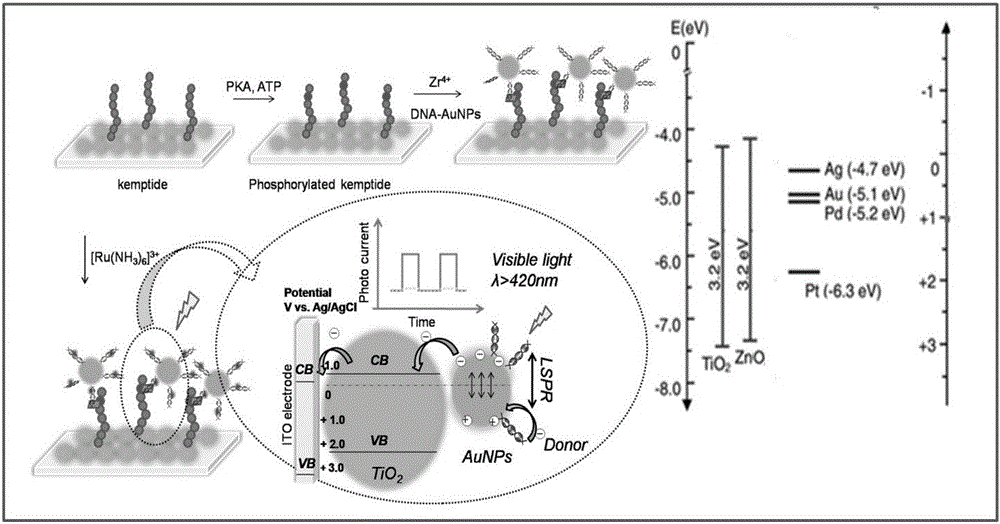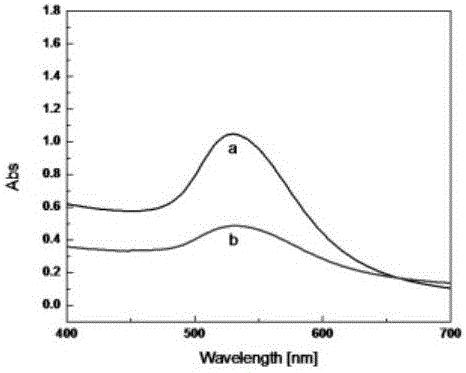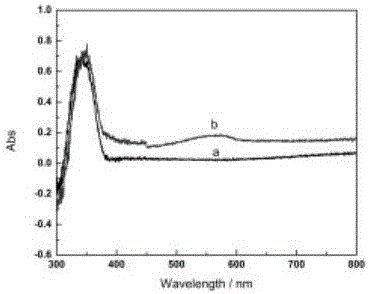Photoelectric sensor for detection of kinase activity on the basis of local area surface plasma resonance
A plasmon resonance, photoelectric sensor technology, applied in instruments, measuring devices, scientific instruments, etc., can solve the problems of inability to directly apply biomolecular detection, influence of biomolecular activity, and low amount of enzyme immobilized in glassy carbon electrodes, and achieve Enhanced localized surface plasmon resonance effect, ultrasensitive detection of kinase activity, and improved photoelectric conversion efficiency
- Summary
- Abstract
- Description
- Claims
- Application Information
AI Technical Summary
Problems solved by technology
Method used
Image
Examples
Embodiment 1
[0043] Fabrication of Photosensors
[0044] 1. Preparation of probes:
[0045] The synthesis of nano gold: 100ml 0.01% (w / v) chloroauric acid aqueous solution is placed on magnetic stirrer and is heated to boiling, after that 0.5mL 1% (w / v) sodium citrate aqueous solution is added rapidly to boiling chloroauric acid In the solution, when the solution turns wine red, the heating is stopped to obtain gold nanoparticles, which are stored at 4°C for later use. The UV-Vis spectrophotometer proves that its absorption peak is at 529nm, corresponding to a particle diameter of 46nm ( figure 2 ).
[0046] 2. DNA modification of gold nanoparticles:
[0047] dna 1 (5′-SH-C6-ATCGTTTAGGATTTGGATGA-P-3′) and DNA 2 (3′-GCAAATCCTAAAC) configured as 10 -6 M solution, and then hybridize and incubate for one hour at 37°C on a mixing shaker. After the reaction is complete, add the hybridized DNA double strands into 1mL nano-gold solution. After stirring at room temperature for 24 hours, add ...
Embodiment 2
[0060] Fabrication of Photosensors
[0061] 1. Preparation of probes:
[0062] The synthesis of nano palladium: the freshly prepared Pd(NH of 100ml 0.01% (w / v) 3 ) 2 Cl 2 Mix the solution with 0.5g / L protective agent polyvinylpyrrolidone in a 10ml colorimetric tube, add the reducing agent polyethylene glycol under mechanical stirring, seal it, and put it in a constant temperature water bath at 60°C. As the reaction progresses, the color of the solution begins Change, stop heating when the solution turns black and does not change to obtain a nano-palladium mixed solution. The mixed solution was centrifuged twice for 15 min at 12000 rpm per minute, and the supernatant was skimmed off to obtain palladium nanoparticles. Re-disperse the nano-palladium in the nano-silver in the Tris-HCl solution containing 300mM sodium chloride and 50mM, and store it at 4°C for future use. Store it at 4°C for later use.
[0063] 2. Nano-palladium modification of DNA:
[0064] dna 1 (5′-SH-C6...
Embodiment 3
[0069] Fabrication of Photosensors
[0070] 1. Preparation of probes:
[0071] Synthesis of nano-silver: add 0.01g of bovine serum albumin into distilled water and stir until the bovine serum albumin is completely dissolved to form a clear and colorless solution, then add 5ml of 0.5M silver nitrate aqueous solution into it, place it on a magnetic stirrer, stir and mix evenly, add a certain amount Ammonia solution was made into silver ammonia solution, and then 0.2 g of ascorbic acid aqueous solution was quickly added to the silver ammonia solution, and stirring was continued for 10 minutes. The mixed solution was centrifuged twice for 15 min at 12000 rpm per minute, and the supernatant was skimmed off to obtain silver nanoparticles. The nano-silver was redispersed in a solution containing 300 mM sodium chloride and 50 mM Tris-HCl solution, and it was stored at 4° C. for future use.
[0072] 2. Nano-silver modification of DNA:
[0073] dna 1 (5′-SH-C6-ATCGTTTAGGATTTGGATGA-P...
PUM
 Login to View More
Login to View More Abstract
Description
Claims
Application Information
 Login to View More
Login to View More - R&D
- Intellectual Property
- Life Sciences
- Materials
- Tech Scout
- Unparalleled Data Quality
- Higher Quality Content
- 60% Fewer Hallucinations
Browse by: Latest US Patents, China's latest patents, Technical Efficacy Thesaurus, Application Domain, Technology Topic, Popular Technical Reports.
© 2025 PatSnap. All rights reserved.Legal|Privacy policy|Modern Slavery Act Transparency Statement|Sitemap|About US| Contact US: help@patsnap.com



